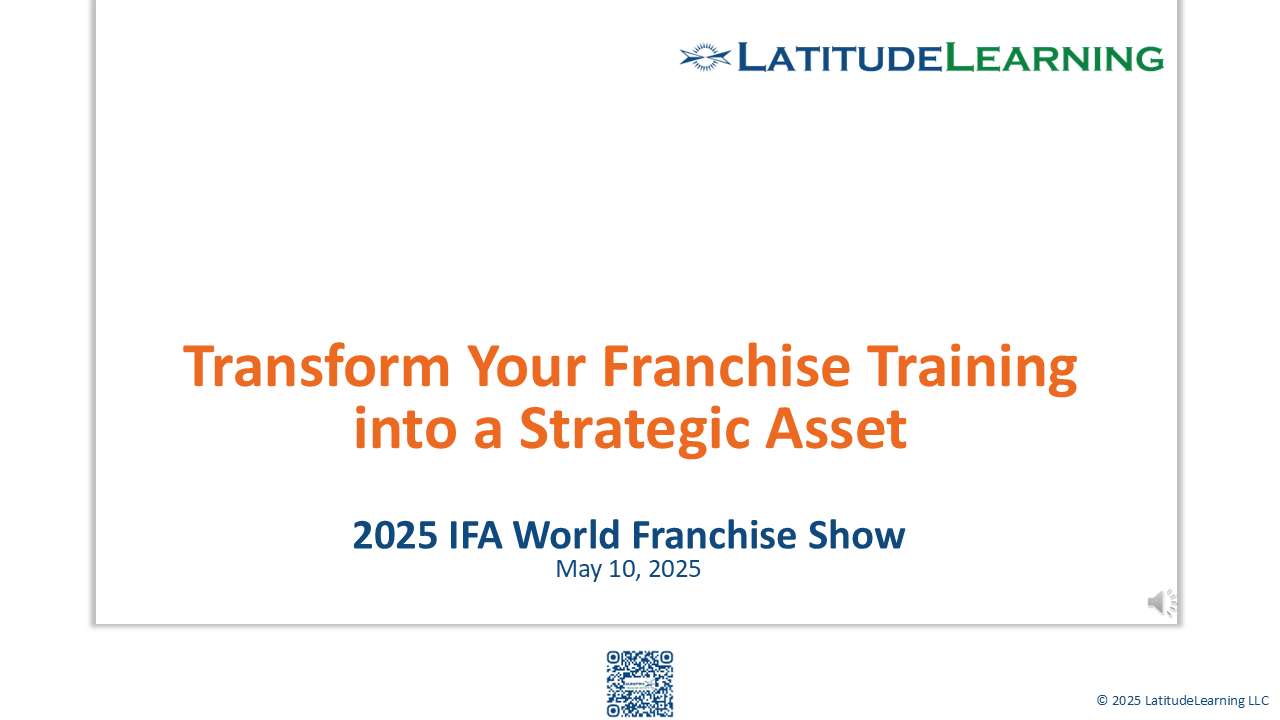
At the 2025 IFA World Franchise Show, Jeff Walter, Founder and CEO of LatitudeLearning, took the stage with a powerful message for franchise executives, learning leaders, and emerging franchisors: Franchise training is not just a necessity—it’s a strategic asset capable of transforming your business.
In his featured session, “Turn Your Franchise Training into a Strategic Asset,” Walter challenged the outdated mindset that training is a cost center, making a compelling case for why it should be treated as a high-return investment. Drawing from over two decades of experience in the Learning and Development industry and real-world client success stories, Walter offered both a strategic framework and tactical solutions for scaling impactful franchise training programs.
Walter began by addressing the way executives allocate money—a critical perspective for anyone trying to secure training budgets or executive buy-in. According to Walter, executives categorize spending in one of two ways: as a cost of doing business (e.g., accounting, compliance) or as a strategic investment (e.g., marketing, R&D) that delivers measurable ROI.
“The goal,” Walter said, “is to move your training program out of the ‘necessary evil’ column and into the ‘growth engine’ column.” He explained that most training programs today are seen as obligations—important, but not revenue-generating. That perception, he argued, limits their potential impact and funding.
Walter laid out the key benefits of effective franchise training, all of which tie directly to business performance:
He shared research and anecdotes that demonstrated how these benefits aren’t theoretical. “We’ve seen it happen with clients again and again. When franchisees are trained properly—along with their teams—locations perform better, customers stay longer, and margins increase.”
One eye-opening point: poorly trained staff are one of the leading causes of early employee turnover, especially in retail and service franchises. “If employees don’t get trained in the first 30 days, they leave. And if they realize no one else is trained either, they leave even faster,” Walter noted. This drives up hiring costs and damages customer experience—two clear bottom-line issues that effective training directly addresses.
To help franchisors evaluate their own programs, Walter introduced LatitudeLearning’s Training Program Roadmap, a five-stage model that shows how training programs evolve:
Each stage includes best practices and increasingly sophisticated learning design. Walter emphasized that moving through these stages isn’t just about complexity—it’s about increasing ROI and strategic value.
Walter contrasted the typical franchise onboarding process—which is usually robust and instructor-led—with the much weaker ongoing employee training many systems rely on.
Most franchisors, he said, offer a solid onboarding journey: weeks of instruction at corporate HQ, field training at a model store, and direct support during a franchisee’s launch. These programs often include live demos, coaching, and skill assessments—a clear Stage 3 effort.
But after the grand opening? Things fall apart.
New employee training is often pushed entirely onto the franchisee. “It becomes a Stage 1 train-the-trainer setup,” Walter explained. Franchisees are expected to onboard new staff using static resources, often without structure, support, or time. The result is inconsistent training, missed standards, and costly employee turnover.
To illustrate how to do it better, Walter highlighted a client in the powersports industry with a dealer network that successfully transformed its training model using LatitudeLearning’s platform.
Their approach:
“This client didn’t just train individuals,” Walter emphasized. “They trained locations. And they tied program participation to real rewards. That’s what made it stick.”
Walter reserved a special message for emerging franchisors, many of whom shared their challenges during the show: They’re growing fast, delivering all training themselves, and struggling to keep up.
His advice: start with blended learning now.
By developing self-paced digital courses, onboarding can be streamlined, and franchisees or employees arrive at instructor-led sessions with foundational knowledge. This saves time, reduces instructor burden, and dramatically improves the quality of in-person training.
Walter offered a phased roadmap based on unit count:
He also highlighted how emerging tech like AI avatars and VR simulation is reducing the cost of coaching and hands-on practice, unlocking new opportunities for scalable, high-impact training.
Walter concluded his session by reiterating that training can—and should—be one of a franchise’s most powerful levers for growth. By aligning training to business outcomes, measuring its impact, and leveraging technology to scale, franchisors can create systems that increase revenue, improve margins, and drive customer loyalty.
“If executives see that every dollar spent on training returns two, five, or ten dollars in value,” Walter said, “you’ll not only get the budget—you’ll get a seat at the strategic table.”
For access to Jeff Walter’s full presentation and related materials, attendees were encouraged to scan QR codes linking to the Surefire Training Impact guide and LatitudeLearning’s homepage.
Whether you’re an emerging franchisor or a mature brand, the message was clear: If you want training to matter—make it perform.